AutomatedBuildings.com
Article - January 2002
[Home Page] |
[an error occurred while processing this directive]
(Click Message to Learn More) |
|
|

The application of a standardized and
internationally accepted protocol for specific applications is still no
guarantee that a device by manufacturer A can be exchanged for one supplied by
manufacturer B. For this purpose, further standardization of design and of the
exact functionality of a device is necessary.
|

Hans R. Kranz
& Othmar Gisler
Siemens Building
Technologies Ltd
Building Automation, Zug, Switzerland
|
ABSTRACT
A short overview on today's trends in BACS
(Building Automation and Control Systems) is presented. The influence of
standard protocols and web technology is analysed, and some of the most
promising ones, in the author's view, are analysed in more detail. The actual
status of the different standard protocols by international standard bodies is
outlined. Finally an outlook is given to how the future in the building
automation world could look in the next few years.
TABLE OF CONTENTS
Trends
and Future Challenges in Building Automation and Control Systems
The Technology Behind
The What, Why and Where of
Standards
What
Has to be Covered by Open Communication Standards for Building Automation and
Control Systems?
BACnet versus LonMark
European Standardization
International Standardization
BACnet, EIB/KNX,
LonMark, etc. - Where to Use What
OPC - A New Alternative?
Some Actual
Customer Needs Covered by Web-Technology
Embedded Web-Server
versus Application Server
Application Server - Target
Groups
Application Server - Solutions
General System Architecture
Will Web-Technology Replace
BACnet?
Summary and Conclusions
TRENDS
AND FUTURE CHALLENGES IN BUILDING AUTOMATION AND CONTROL SYSTEMS
Facilities must meet business needs more and more
closely and reduce operating and maintenance costs. Leaner budgets and
environmental considerations demand advanced energy management. Growing
expectations for comfort and service require advanced managerial instruments.
Every enterprise has a unique pattern of building
management requirements. Freedom to choose the right solution to meet specific
needs is crucial.
It's time to change the way we look at facility
and building management. Only a coherent automation and control framework,
within which many different systems are to evolve, can remove the barriers to
progress. A common interface, Open, normative system standards, Web Technology
and advanced integration are prerequisites for success.
Below is a list of actual customer requirements.
-
Reduction of initial investments
-
Building Automation uses existing IT and CT
infrastructure
-
A unique user interface for all building
disciplines (HVAC, Lighting, Lifts, Fire, Access, Intrusion,
)
-
Customers want higher supplier independence in
case of later system enhancement
-
Reduction of operating, energy
and
maintenance costs
-
Mobile operators want to operate the building
at any time, from everywhere, immediately
-
Less trained operator needs
"obvious" operating
-
Technical competence centre serves many
buildings in a defined geographical region
-
Growing expectations for comfort and service
-
Reduced energy consumption
the answer: System and
Communication Standards and Web-Technology

THE
TECHNOLOGY BEHIND
[an error occurred while processing this directive]System
Standards for BACS
The main expenditure is in the efforts for the complete engineering of BACS
plants. The costs are in direct relation to the type and amount of functions
necessary. The I/O points just provide - or use - the signals. To avoid
unnecessary risks for costs at tendering, execution and billing the use of
standardized terms is necessary. Free and fair competition, including the potential
for innovations, is only possible by specifications using a unique language for
all parties involved. The CEN/TC247WG3 has developed a set of standards for a
common understanding of hardware and functions. This definition of functions
helps i.e. in the case of system integration to determine the tasks of each
involved system and to calculate the proper costs for the system engineering.
This work has been adopted by the relevant ISO committee TC205.
Communication Standards for BACS
Standardised communication protocols such as BACnetTM, EIB/KNX, LONMARK®, etc.
and interfacing standards such as OPC (OLE for Process Control) allow exchange
of information between different manufactures devices, systems and programs in
an agreed way. Communication standards are the prerequisite for cost efficient
integration of various manufactures subsystems.
IT & Web Technology
State-of-the-Art
IT and Web-Technology is widely used by BACS. This allows smooth
data-exchange with the customer's office automation system and business process.
Existing communication infrastructure such as LAN / WAN (Wide Area Networks) can
be shared - which reduces cabling cost and allows flexible solutions. Web
technology brings additional benefits such as easier and central software
updates & maintenance / local operation using slim, low cost clients (only a
browser is needed).
Some of the most important
technologies from the IT world are: Ethernet, TCP/IP, Int@net, Web, OLE/COM, XML,
SOAP.


Communication standards for
BACS IT & Web technology
THE
WHAT, WHY AND WHERE OF STANDARDS
Efficiency Means Profitability
An integrated management system enables a building to be operated more easily
and with greater efficiency, so helping to reduce operating costs and increase
profitability. Instead of using a variety of dedicated devices for operation,
the facility manager's team can perform all activities from operator stations
with the same look and feel, keeping training and operating costs to a minimum
and reducing the likelihood of incorrect operations. Dedicated security systems,
of course, send their alarms to the security guards and the
fire brigade. However, if information of all systems in the building is brought
together to one or to many networked operator stations with unique human
interface, faults and alarms can be identified and dealt with immediately, for
the better protection of people and property.
Precondition for System Integration
Stable and reliable communication is one precondition for system integration. Protocols
and functions must be exactly described if successful performance and
integration is to take place. In the case of multi vendor systems integration, the
right contracts, mutual coordination and agreed upon responsibility is
indispensable. Nevertheless, there are practical limits to implementation:
-
The fusion of different concepts is difficult
and demands considerable investment of time and energy. This is hardly
justifiable for a single application!
-
The delimitation of responsibility at the
interfaces and uncoordinated alterations in the subsystems represent almost
intolerable complications for integration.
To overcome these limits the industry agreed on
communication standards, which describe the basic functions in the disciplines
of HVAC, lighting, safety, etc. These basic functions defined as objects can
then be exchanged by different services, disciplines or management systems
easily and with a minimum of effort via communication networks, routers,
gateways etc.
Integration will only be really successful,
however, when standard protocols are implemented internally within the
individual systems. This eliminates complex conversion and, above all, too much
loss of functionality. The standardization of engineering data and the
engineering and commissioning workflow in the future will further help to lower
costs and to increase the reliability and functionality of integrated
systems!
Typical applications in a building: air, water,
lighting and sun-blinds, heating, cooling, ventilation, energy distribution,
safety and security, refrigeration, transportation and ancillary systems.


(The user; source: Michael
Newman, ASHRAE)
Integration plays a key role in bringing down
operating costs and allows us to look at the building as one single process.
WHAT
HAS TO BE COVERED BY OPEN COMMUNICATION STANDARDS FOR BUILDING AUTOMATION AND
CONTROL SYSTEMS?
I would like to highlight some concepts on which
to focus our attention when deciding which protocol is the right solution for
BACS.
The involved parties should consider different
topics when deciding which standard protocol fulfils the requirement. The
following main issues have to be addressed:
|
|
has to
provide all complex and simple data structures to accomplish daily
functions like:
|
|
|
-
Exchange
data between devices
-
Monitor
& operate inputs, outputs, setpoints, alarms
-
Time
Scheduling
-
Online
Grouping / Regrouping
-
Trend /
History
-
Backup /
Restore
|
|
|
The
data approach has to be object oriented.
|
|
|
has to
support services for system start-up, network management and
back-up / restore.
|
|
|
has to
provide independent media access to support modern IT & CT networking
standards and cabling systems.
|
|
|
has to
allow extensions to provide the possibilities of future innovations.
|
The European standardization committee had to
weigh up over 100 issues for the selection of the present pre-standard
protocols.
BACnet VERSUS
LONMARK
If we apply above criteria to BACnetTM and
LonMark® we get the following picture.

. and as we can see, a clear positioning where
to use what:
LonMark®
[an error occurred while processing this directive]
We talk about
LonMark, because the LonTalk® protocol is a proprietary product from Echelon
Inc. The defined LonMark
templates cover the functionality needed for the field level: Data
exchange and interactions between devices on the same bus, monitoring of values
such as temperatures, operating states and simple control functions e.g. lights
on/off, etc. The field device functions are normally implemented in one single
chip (the Neuron® and the LonWorks® transceivers support a range of
transmission media, e.g. the inexpensive Cat. 4 cables. In addition there is a
relatively large (>180) number of manufacturers available to choose devices
for building applications from, but the product's ability for interoperation has
to be checked by the system integrator.
All this may give the LonWorks based
products a future potential to network at the field level. But
"normal" sensors and actuators cost less - from a point of view
without taking the overall system costs and the engineering into account.
EIB/KONNEX
The application of a standardized and
internationally accepted protocol for specific applications is still no
guarantee that a device by manufacturer A can be exchanged for one supplied by
manufacturer B. For this purpose, further standardization of design and of the
exact functionality of a device is necessary. One step in this direction has
been made by the EIB concept for building applications. Each of the more than
5,000 available EIB devices is supplied with its relevant parameterization data
stored on a floppy disc which can be used - together with the neutral EIBA tool
software ETS (11.000 licenses in use) - by the installer for combination. (EIBA
= European Installation Bus Association, Brussels/Belgium).
There are 65
certified training organizations and 15 national EIBA Organizations. More than
70.000 projects have been finished all over the world.
Today's market provides
such an extreme diversity of applications that an all-comprehensive testing
procedure is hardly feasible under economic aspects. Testing is less arduous and
expensive for less sophisticated devices (e.g. devices for the European
Installation Bus EIB) whose range of functions has been defined through "interworking
standards". The EIB Functional blocks describe not only the semantics of a
function in English language, but also define how to access the services
associated with that function. This is done on the base of Data Points.
The EIB
Communications Protocol is part of ANSI EIA 776.1 to .5 standard and
incorporates a CEBus - EIB Router.
EIBA has been assigned a unique BACnet vendor
ID (74, decimal) by the ASHRAE organization. This vendor ID must be used for the
mappings of EIB applications to BACnet. The document ISO/TC205WG3 BACnet draft
addendum H.5 describes how European Installation Bus (EIB) Functional Blocks,
which are part of Object Interface Specifications (ObIS) of the Interworking
Model defined by the EIB Association (EIBA), are mapped to the corresponding
Building Automation and Control networks (BACnet) object model definitions.

EIB - the true interchangeability
In a convergence project the three European
Associations EIBA, BCI, EHSA have been migrated to the Konnex Association (March
2001) and the protocols "EIB", "BatiBus" and "EHS"
grow together to the "KNX" (Konnex) protocol.
BACnet
In most other protocols there are some
basic BACS functionalities missing for open interoperability. Services and
functions which are needed
for mature building management such as: Trend / History, Time Scheduling,
Back-up/ Restore, Remote Management, Alarm Distribution, and many others.
BACnet covers all these requirements. In addition
BACnet supports, in a flexible way, modern IT and networking technology such as
Ethernet and IP (Internet Protocol) as this is needed in today's modern IT
environments.
BACnet is therefore the best choice for the upper
system levels where a broader functionality and full IT compliance is needed.
EUROPEAN
STANDARDIZATION
After having analysed these main topics in order
to decide which standard protocols are preferred for our BACS system, we should
have a look also at the standardization situation in Europe, because there,
the open communication was started earlier then anywhere else. Implementation
began in Germany in 1984 with IBM's FACN protocol, followed by the
FND in 1987.
European pre-standards for communication
protocols in BACS:
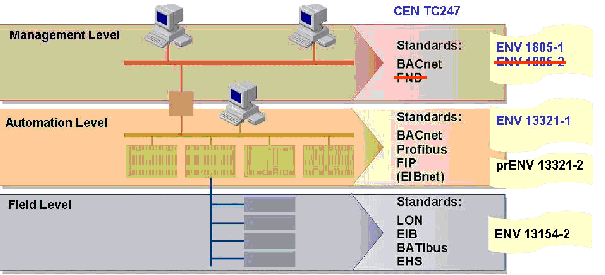
As we can see there is not just one single
communication standard - but for each functional "system level" there
is a choice of various standards with different functionalities and benefits.
Since there were over 20 protocols in the beginning of the standardization
process (1990), the decision was to limit the number to three per functional
level. So the consensus, rather than the compromise, is shown in the picture.
Fortunately the experimental standards may only stay for 5 years, then a new
decision must be made. The FND was withdrawn as a standard in 2001, but it
still is there as a "private" public document. The experts within CEN
decided to treat the other protocols also in relation to their acceptance in the
marketplace.
BACnet is the only standard covering management,
automation and field level functions in an open standardized way, supporting
various data transportation methods. This brings additional benefits for
customers and system integrators: Since no protocol conversion is needed we get
higher functionality at lower cost (no gateways needed) - the upper two system
levels can be collapsed and even more complex field devices can be integrated.
On the field level both EIB/KNX and
LonMark have
future potential. EIB, BATIbus and EHS are about to evolve to one new standard:
KONNEX (KNX), the EIBA has migrated to the Konnex Association covering over one
hundred producers.
-
LonMark is well suited for complex field level
applications where a certain engineerable flexibility is required.
-
KONNEX (KNX)
will be optimal for standard solutions - cost effective, simple and easy to
implement.
INTERNATIONAL
STANDARDIZATION
The ISO/TC205 committee treats the
Building Automation and Control System in its WG3 standard. This covers hardware,
functions, applications, communication, conformance testing, project and system
implementation. There is only one protocol without any level dedication: BACnet
as ANSI/ASHRAE 135. It is expected that the EIB/KONNEX Functional Blocks, which
are part of the EIB Object Interface Specification, will become a part of the BACnet
specification by mapping them to the BACnet objects. It is also expected to have
the first worldwide enquiry in 2002. This ISO enquiry will be also be done in
parallel among European countries, so we can expect to have one protocol
standard for BACS all over.
BACnet,
EIB/KNX, LONMARK, ETC. - WHERE TO USE WHAT
So where to use what? After considering all the
above the picture gets clearer.
On the floors, for Room Automation, where a large
number of devices have to be linked together and to interact - EIB/KNX for real
open craftsmen solutions and - LonMark for more complex engineered solutions.
Both offer good cost-effective products covering the functionality needed.
In the plant rooms - more functionality is needed
- this functionality is currently best covered in a standard way by BACnet. For
BACnet the most effective physical media has to be selected, e.g. the same as
for the floors. For management applications we need in addition to BACnet's high
functionality also its IT compliance, so here BACnet on Ethernet/IP will cover
the requirements.
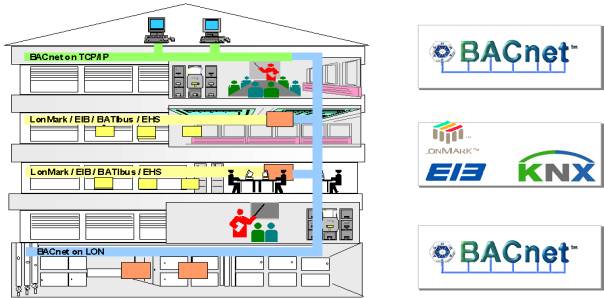
OPC - A NEW
ALTERNATIVE?
OPC stands for "OLE for Process
Control", a communication standard based on OLE/COM technology that brings
the same benefits to industrial hardware and software that standard printer
drivers brought to word processing.
Based on Microsoft's OLE, COM (Component Object
Model) and DCOM (Distributed Object Model) technologies, OPC consists of
standard interfaces, properties and methods for use in process control and
manufacturing-automation applications.
The OLE/COM technologies define how individual
standard components can interact and share data.
OPC provides an interfacing standard for factory
automation where every system and every communication driver can freely connect
and communicate. Having such a standard, the communication and
interactions between different applications, from the plant to the MIS
(Management Information System), becomes easier with truly open enterprise
communication.

OPC
what it is not?
OPC is not a new
standard bus or a universal protocol, but it is an interface definition defined
by different companies from industrial automation and Microsoft.
The complex data structures definition are not
yet fully defined in OPC, leaving them dependent on the application. From the
driver point of view, it is still vendor specific.
SOME
ACTUAL CUSTOMER NEEDS COVERED BY WEB-TECHNOLOGY
Web technology is found almost
everywhere. The following attributes go with the Internet, which are also valid
for web applications within BACS:
-
Global connectivity
-
Global companies need
global BMS information
-
Easy to operate
-
Access at any time, from everywhere,
immediately
-
Use mainstream technology
-
IT-world compliance
-
Slim,
inexpensive clients
In addition, the web technology facilitates and
centralises software maintenance, updates and support. Last but not least, the
web offers new services and opens up new business opportunities.
EMBEDDED
WEB-SERVER VERSUS APPLICATION SERVER
Web technology can be implemented in
almost any
device from small embedded systems like a DDC controller to large application
servers. Do we need in future still conventional management stations or can they
be fully replaced by embedded systems?
Let's look where BACS functionality
can be realised using web technology:

As we can see, for small and simple applications
where functionality such as graphical plant operation, alarming, simple trending
and reports are needed embedded Web-Servers can and will fully cover this area.
For larger and/or distributed installations where centralised functions such as
navigation between various sites, alarm dispatching, data evaluation, billing,
statistics, maintenance management, etc. are required a central application
server will be needed.
Web-embedded systems and application servers are
complementary. Functionality and data management is distributed on autonomous
servers within an intranet / internet.
APPLICATION
SERVER - TARGET GROUPS
Application servers will address the following
target groups:

APPLICATION
SERVER - SOLUTIONS
The application server will primarily support the
following technical and technological solutions:
Operating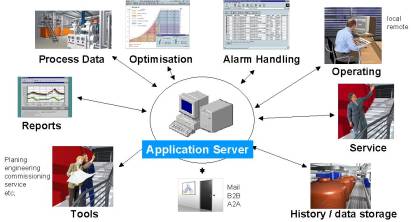
-
Reporting
-
Alarm handling
-
Plant
optimisation
-
Security
-
Lighting
-
HVAC
-
Media access
-
Room Automation
Data Management
-
Reporting
-
Energy data
evaluation
-
Consumption Control
-
Process data evaluation
-
Trends
-
Billing
-
Error and System Log
Service and Maintenance
Integration Platform
-
Integration on operating
level (e.g. using ActiveX)
-
Subsystem integration via standards communication
protocols and interfaces (BACnet, EIB/KNX, LONMARK, OPC, ... )
-
Data exchange
with customers business processes, office environment, etc.
GENERAL
SYSTEM ARCHITECTURE
In the traditional Windows based management
stations business logic and presentation (using e.g. MS Windows) are running on
the same HW platform, normally a personal computer. With state-of-the-art web
technology the presentation layer and the business logic is separated.
To view
and operate the system only a simple web browser is needed, which runs on a
large variety of clients. The core part, the business logic, where functions
such as alarm routing, trend / history data evaluation, etc. are realised,
remains on a dedicated machine, the application server.
Real-time process data
is handled by dedicated DDC controllers optimised for the various building
management disciplines.
Standard database, preferably the leading IT standards
SQL / MSDE are used to store engineering and process data on the management
level.
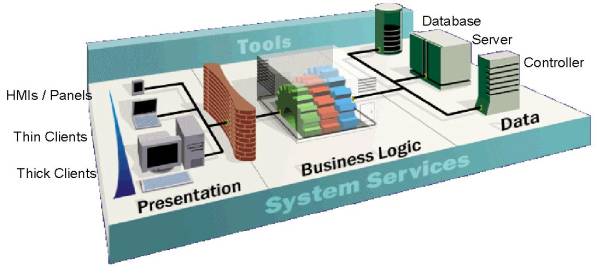
WILL
WEB-TECHNOLOGY REPLACE BACnet?
Communication protocol between web-server and
clients is based on the leading edge Internet technology such as HTML, DHTML,
XML, SOAP, .NET-framework. These standards out of the IT world are optimised for
their specific purposes: to transmit data needed for presentation by slim to fat
clients through firewalls over the Intranet / Internet.
For communication between subsystems and
application server the specific BACS functionality such as trending / history,
alarming, scheduling etc. has to be covered. Here BACnet is the right
choice. Only BACnet currently provides this functionality within an open
standard format - to assure interoperability between different systems in an
open way.
So we see both BACnet & the Web are needed!

SUMMARY AND
CONCLUSIONS
-
Proprietary communication protocol will lose
importance.
-
There will be a limited number of communication and interfacing
standards which will dominate.
-
BACnet, EIB/KNX, LONMARK, OPC have good future
potential.
-
Debundling - best of breed solution for every level / application.
-
More and more integration of all technical applications.
-
Turnkey solutions from
one supplier.
-
Web technology will be used on operating level.
-
Both embedded
servers and applications servers will play important roles and allow distributed
functionality and data management in geographical networks.
-
Technologies with
very good future potential are: HTML, DHTML, XML, SOAP, NET-framework.
-
BACnet,
OPC and Web are complementary technologies.
-
Application Service Providers will
offer new ways to operate optimise and manage a building.
And do not forget: We have tried to explain in
which direction the building automation and control industry is moving - as
usual, however the marketplace will take the final decision!
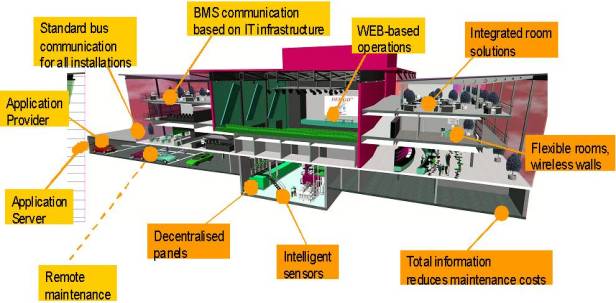
More
Articles
[an error occurred while processing this directive]
[Click Banner To Learn More]
[Home Page] [The
Automator] [About] [Subscribe
] [Contact
Us]

















